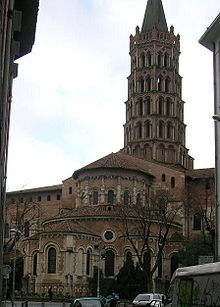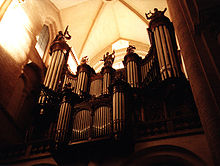- Basilica of St. Sernin, Toulouse
-
The Basilica of St. Sernin is a church in Toulouse, France, the former abbey church of the Abbey of St. Sernin or St. Saturnin. It was built in the Romanesque style between about 1080 and 1120. It is located on the site of a previous basilica of the 4th century which contained the body of Saint Saturnin or Sernin, the first bishop of Toulouse in c. 250.
Contents
History
The abbey of St. Sernin was an ancient foundation. St. Sylvius, bishop of Toulouse, began construction of the basilica towards the end of the 4th century.[1]
Its importance increased enormously after Charlemagne (r. 768-800) donated a quantity of relics to it, as a result of which it became an important stop for pilgrims on their way to Santiago de Compostela, and a pilgrimage location in its own right. The current building was built to accommodate these pilgrims.
The plan of the abbey church here was also used in the construction of the cathedral of Santiago de Compostela, "begun in 1082, too direct a copy to have been done by any but St. Sernin's own architect or his favorite pupil", but finished much earlier[2].
The stone that killed Simon de Montfort in 1218, while he was besieging Toulouse, was thrown from the roof of St. Sernin's.
In 1860, Viollet-le-Duc restored the church, but his changes are currently being removed to restore the original appearance.
Features
Despite being called a basilica, St. Sernin's deviates from the basilica plan of early Christian architecture in a few ways. It is much larger compared to earlier churches. It is also constructed mostly of brick. The building is in the form of a crucifix. The ceilings are vaulted, unlike many of the earlier churches. St. Sernin's contains radiating chapels which were used to display important relics. Another deviation from the earlier Christian churches is the addition of an ambulatory, a walkway that goes around the nave and side aisles to allow for viewing of the radiating chapels (which could be done while mass was being held without interrupting the ceremony). For these and other reasons, St. Sernin's is often said to follow the "pilgrimage plan" instead of the traditional basilica plan.
Exterior
On the exterior, the bell tower, standing directly over the transept crossing, is the most visible feature. It is divided into five tiers, of which the lower three, with Romanesque arches, date from the 12th century and the upper two from the 14th century. The spire was added in the 15th century. The bell tower is slightly inclined towards the west direction, which is why from certain standpoints the bell tower roof, whose axis is perpendicular to the ground, appears to be inclined to the tower itself.
The chevet is the oldest part of the building, constructed in the 11th century, and consists of nine chapels, five opening from the apse and four in the transepts.
The exterior is additionally known for two doorways, the Porte des Comtes and the Porte des Miégeville. Above the Porte des Comtes is a depiction of Lazarus and Dives. Dives in hell can be seen above the central column. The doorway gets its name from a nearby alcove in which the remains of four Counts of Toulouse are kept. The Porte des Miégeville is known for its elaborate sculpture above the entrance.
Interior
The interior of the basilica measures 115 x 64 x 21 meters, making it vast for a Romanesque church. The central nave is barrel vaulted; the four aisles have rib vaults and are supported by buttresses. Directly under the tower and the transept is a marble altar, consecrated by Pope Urban II in 1096 and designed by Bernard Gelduin.
As well as Saint Saturnin, Saint Honoratus is also buried here. The crypt contains the relics of many other saints.
The basilica also contains a large three-manual Cavaillé-Coll organ built in 1888. Together with the Cavaillé-Coll instruments at Saint-Sulpice in Paris and the Church of St. Ouen, Rouen, it is considered to be one of the most important organs in France.
Notes
Sources
- O'Reilly, E.B., 1921: "How France Built her Cathedrals". London and New York: Harper and Brothers
External links
Categories:- Churches in Toulouse
- Basilica churches in France
- Pipe organs
- Romanesque architecture in France
- World Heritage Sites in France
Wikimedia Foundation. 2010.




